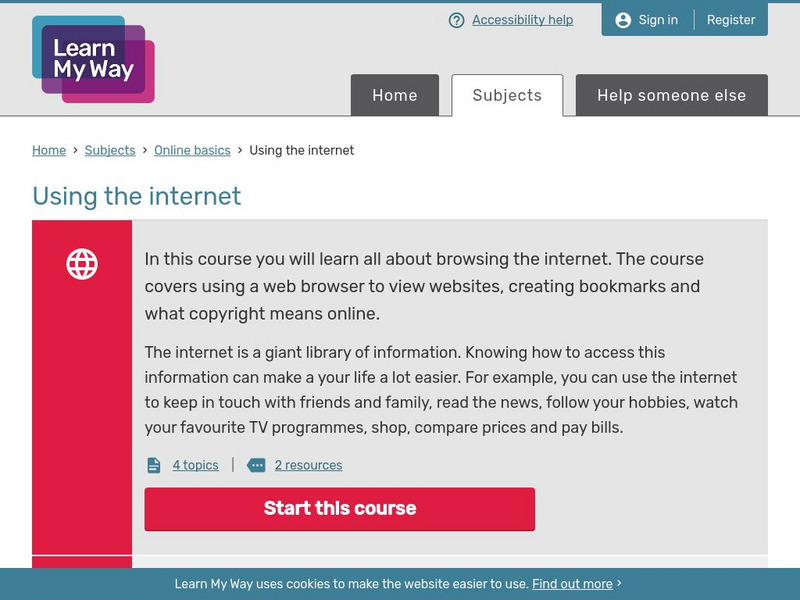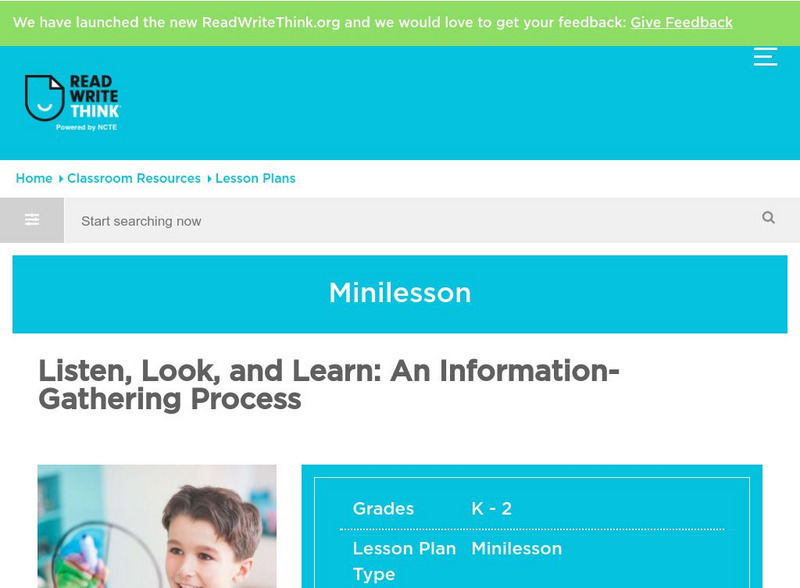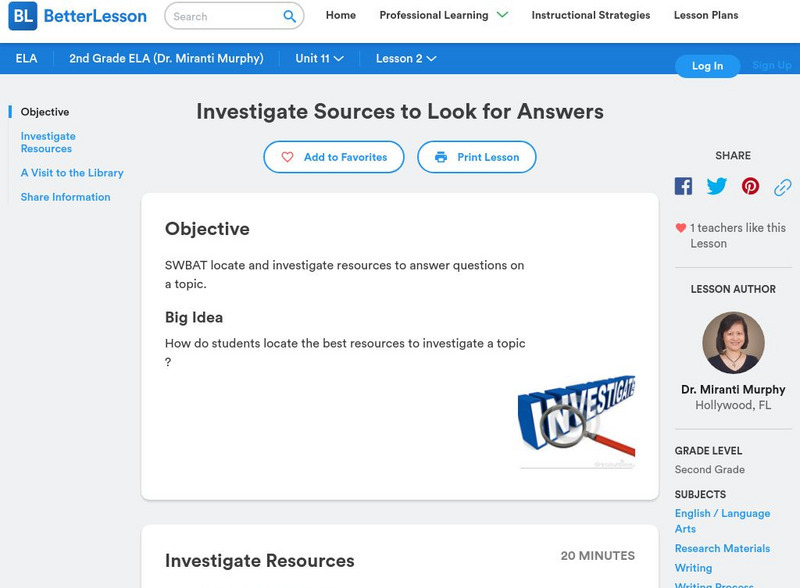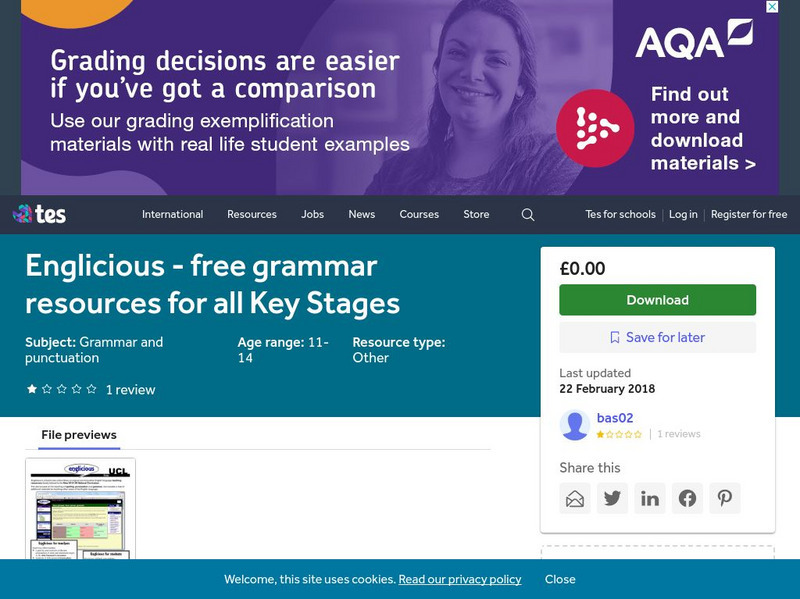National Geographic
National Geographic: Reading a Resource Map
Students will study maps to recognize where natural resources are found through exercises provided.
Other
Literature Circles Resource Center: Teaching Students How to Discuss
Teachers are given strategies and hands-on approaches to help students prepare for a discussion and participate as active members of it.
K-5 Math Teaching Resources
K 5 Math Teaching Resources: Adding Tens to a 2 Digit Number [Pdf]
Students will flip two cards over and determine the sum. Base ten blocks could be used for additional help.
Learn My Way
Learn My Way: Using the Internet
In this online course, students will learn all about browsing the Internet. They'll learn about using a web browser to view websites, how to create bookmarks, and what copyright means for online resources.
TES Global
Tes: Printed Quiz on 11: Plus Verbal Reasoning Hidden Word
[Free Registration/Login Required] This site provides several word puzzles for students. When given sets of phrases, students will find four-letter words hidden within each set.
ReadWriteThink
Read Write Think: A Genre Study of Letter With the Jolly Postman
In this lesson outline based on The Jolly Postman by Janet and Allan Ahlberg, students learn about parts of a letter, the different genres of mail, and letter attributes by studying the letters included in the book.
National Women’s History Museum
National Women's History Museum: Who Do I Admire?
Who are our real life heroes? Learners will learn and write about inspirational women.
ReadWriteThink
Read Write Think: Listen, Look, and Learn: An Information Gathering Process
This lesson models an information-gathering process for primary learners as they listen to and look at resources, seeking information pertinent to the questions on an information wheel. Guiding the listening, looking, and learning...
ReadWriteThink
Read Write Think: Seasonal Haiku
This site is a three-part lesson that teaches students how to write and depict seasonal imagery through haiku. Students study, listen to, and create original haiku on colored backgrounds.
ReadWriteThink
Read Write Think: Compiling Poetry Collections and a Working Definition of Poetry
Contains plans for eight lessons in a poetry unit that asks students to write poetry in various forms after reading models. In addition to objectives and standards, this instructional plan contains links to sites used in the lessons as...
University of Texas at Austin
University of Texas: Elementary Math Club: The Human Counting Machine
Students investigate the concept of a number as a quantity. The lesson plan includes an overview and a lesson toolkit.
University of Texas at Austin
University of Texas: Elementary Math Club: "Guess the Number" Magic Trick
Students investigate the concept of a number as a quantity. The activity has learners convert back and forth between decimal and binary expansions of numbers. The lesson plan includes an overview and a lesson toolkit.
PBS
Pbs: No Nonsense Grammar: Using Proper Punctuation for Titles
This video focuses on correctly punctuating titles. Small works (short stories, essays, magazine and newspaper articles, etc.) are indicated with the use of quotation marks. Larger works, such as books or movies, are indicated either...
CK-12 Foundation
Ck 12: 1.4: Sometimes a Vowel, Sometimes a Consonant:
[Free Registration/Login may be required to access all resource tools.] Spelling rules with examples for words that contain the letter "u."
New Zealand Ministry of Education
New Zealand Government: Te Kete Ipurangi: Teaching Technological Systems
Two teachers approached the technological systems component of the curriculum through a "simple is best" strategy. By the end of the unit, their students had used simple circuits to develop their understanding of technological systems...
Library of Congress
Loc: Teachers: Personal Stories and Primary Sources
Students will explore the value of personal stories and first-hand accounts when exploring history, in this case, the events of the early twentieth century, which included World War I and the Great Depression. Through this five-unit...
Common Sense Media
Common Sense Media: Education: Lesson: Device Free Moments
[Free Registration/Login Required] In this lesson, 2nd graders learn when it's appropriate to use technology and when it's not, and practice making family rules for device-free time at home. Includes lesson plan, slideshow, student...
Daily Teaching Tools
Daily Teaching Tools: Five Ways to Practice Spelling: Trace, Copy, and Recall
This Daily Teaching Tools resource relates to word study. Students will learn the spellings of new words by tracing and copying so that they can recall them.
Other
Bmw: Safe on the Streets
The BMW Group offers interactive, fun, easy-to-use resources for teachers, parents, and students to help find ways to keep safe on the streets. Provides safety tips, activities, and quizzes that help you learn to be safe whether you are...
Better Lesson
Better Lesson: Investigate Sources to Look for Answers
Students will practice locating and investigating resources to answer questions on a topic using the FINDS research process. FINDS is an acronym describing its five-step research process: Focus, Investigate, Note, Develop, and Score. A...
TES Global
Tes: Englicious
[Free Registration/Login Required] This site provides a preview for free website, Englicious.org, a resource that can help students with English and writing skills.
CK-12 Foundation
Ck 12: Elementary Math: Difference Between Two Time Intervals
[Free Registration/Login may be required to access all resource tools.] Students compare the times on two clocks and calculate what time it will be before or after a given time interval, which clock shows an earlier or later time, etc....
Other
Science and Kids Activities: Pollination and Seed Dispersal
Second graders learn how plants depend on animals to disperse their seeds. Students will learn about ways that animals can disperse seeds. They will design their own model and compare it to the real action of plants and animals. In the...
Stephen Byrne
History for Kids: Greek Daily Life
History for Kids presents an overview written for elementary students of daily life of the ancient Greeks. Students learn about Greek government, agriculture and industry, houses and food. Teacher resources included.
Other popular searches
- Student Resources and Sound
- Student Resources Germany
- Student Resources Food
- Student Resources Chickens
- Student Resources 2nd Grade
- Student Resources Maths
- Student Resources Spanish
- Student Resources Cookery


![K 5 Math Teaching Resources: Adding Tens to a 2 Digit Number [Pdf] Activity K 5 Math Teaching Resources: Adding Tens to a 2 Digit Number [Pdf] Activity](https://d15y2dacu3jp90.cloudfront.net/images/attachment_defaults/resource/large/FPO-knovation.png)















